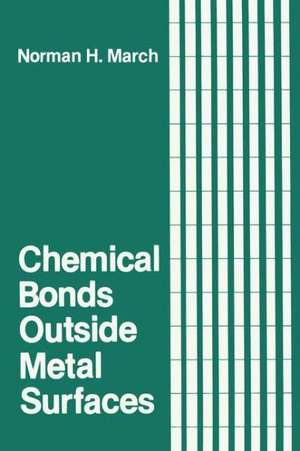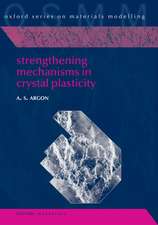Chemical Bonds Outside Metal Surfaces: Physics of Solids and Liquids
Autor Norman H. Marchen Limba Engleză Paperback – 30 sep 2011
Din seria Physics of Solids and Liquids
- 20%
 Preț: 569.92 lei
Preț: 569.92 lei - 20%
 Preț: 1259.13 lei
Preț: 1259.13 lei - 18%
 Preț: 951.47 lei
Preț: 951.47 lei - 18%
 Preț: 1239.37 lei
Preț: 1239.37 lei - 18%
 Preț: 1228.62 lei
Preț: 1228.62 lei - 24%
 Preț: 1555.81 lei
Preț: 1555.81 lei - 18%
 Preț: 952.40 lei
Preț: 952.40 lei - 18%
 Preț: 1232.26 lei
Preț: 1232.26 lei - 18%
 Preț: 1240.62 lei
Preț: 1240.62 lei - 18%
 Preț: 1114.34 lei
Preț: 1114.34 lei - 18%
 Preț: 1236.82 lei
Preț: 1236.82 lei - 18%
 Preț: 1392.95 lei
Preț: 1392.95 lei - 15%
 Preț: 650.55 lei
Preț: 650.55 lei - 15%
 Preț: 646.43 lei
Preț: 646.43 lei -
 Preț: 409.69 lei
Preț: 409.69 lei -
 Preț: 396.78 lei
Preț: 396.78 lei -
 Preț: 406.80 lei
Preț: 406.80 lei -
 Preț: 408.37 lei
Preț: 408.37 lei -
 Preț: 409.30 lei
Preț: 409.30 lei -
 Preț: 384.31 lei
Preț: 384.31 lei -
 Preț: 434.72 lei
Preț: 434.72 lei - 15%
 Preț: 660.04 lei
Preț: 660.04 lei
Preț: 387.58 lei
Nou
Puncte Express: 581
Preț estimativ în valută:
74.17€ • 77.69$ • 61.47£
74.17€ • 77.69$ • 61.47£
Carte tipărită la comandă
Livrare economică 08-22 aprilie
Preluare comenzi: 021 569.72.76
Specificații
ISBN-13: 9781461292524
ISBN-10: 1461292522
Pagini: 300
Ilustrații: 294 p.
Dimensiuni: 152 x 229 x 16 mm
Greutate: 0.4 kg
Ediția:Softcover reprint of the original 1st ed. 1986
Editura: Springer Us
Colecția Springer
Seria Physics of Solids and Liquids
Locul publicării:New York, NY, United States
ISBN-10: 1461292522
Pagini: 300
Ilustrații: 294 p.
Dimensiuni: 152 x 229 x 16 mm
Greutate: 0.4 kg
Ediția:Softcover reprint of the original 1st ed. 1986
Editura: Springer Us
Colecția Springer
Seria Physics of Solids and Liquids
Locul publicării:New York, NY, United States
Public țintă
ResearchCuprins
1. Background, Phenomenology, and Motivation.- 1.1. Chemisorption in Ionic and Covalent Limits.- 1.2. Kinetics of Adsorption and Desorption.- 1.3. Thermodynamics of Adsorption.- 1.4. Reaction Mechanisms Outside Surfaces.- 1.5. Case History of Catalytic Hydrogenation of Carbon Monoxide.- 2. Diatomic Molecules.- 2.1. Physisorbed Diatoms with Weil-Defined Cores.- 2.2.1. Physisorbed H2.- 2.3. Interaction Energy: Tight-Binding Model.- 2.4. Molecular Versus Dissociative Adsorption.- 2.5. Detailed Bonding Studies.- 2.6. Electronically Excited States of Chemisorbed Diatoms.- 2.7. Orientation of Molecular Adsorbates.- 2.8. Temperature Effects, and Comparison Between Theory and Experiment.- 3. Conformation and Electronic Structure of Polyatomic Molecules.- 3.1. Conformation of a Water Molecule Outside a Metal Surface.- 3.2. Conformation of NH3 and C2H4 Molecules.- 3.3. Molecular Versus Dissociative Adsorption of NH3 on Transition-Metal Surfaces.- 3.4. Electronic Structure and Conformation of Ethene on Transition- and Noble-Metal Surfaces.- 3.5. Interaction Between Adsorbates.- 3.6. Electronic Excited States of Chemisorbed Polyatomic Molecules.- 4. Dynamics of Adparticles and Neutron Inelastic Scattering.- 4.1. Principles of Neutron Scattering from Adsorbed Molecules.- 4.2. Comparison With Other Surface Techniques.- 4.3. Diffusion Measurements.- 4.4. Theory.- 4.5. Electronic and Vibration-Rotation Spectra of Adsorbed Molecules.- 4.6. Adsorbate Frequency Shifts.- 4.7. Theoretical Framework for Interpreting Neutron Inelastic Scattering From Covered Surfaces.- 4.8. Theory of Surface Diffusion.- 4.9. Vibration Excitation in Molecule-Surface Collisions Due to Temporary Negative Molecular-Ion Formation.- 4.10. Adparticle Dynamics: Kramers’ Equation in a Metallic Medium.- 5. MolecularDesorption.- 5.1. Kramers’ Theory Generalized to Desorption From Solid Surfaces.- 5.2. Transition-State Theory Applied to Desorption From Solid Surfaces: Ammonia on Ni(111).- 5.3. Microscopic Theories.- 5.4. Quantum-Statistical Theory of Physisorption.- 5.5. Coverage-Dependent Regime.- 5.6. Desorption Induced by Electronic Transitions.- 6. Catalysis.- 6.1. Some Definitions and Concepts.- 6.2. XPS Studies of Desorption and Dissociation Processes.- 6.3. Compensation Effect.- 6.4. Relevance of Woodward—Hoffmann Rules to Single-Crystal Catalysts.- 6.5. Electronic Structure Study of a “Poisoned” Catalyst Surface…..- 6.6. Chemical Oscillations.- Appendixes.- 1.1. Surface Characterization Techniques Used to Determine Structure and Composition of Solid Surfaces.- 2.1. Density Matrix and Linear-Response Function of the Infinite-Barrier Model of a Metal Surface.- 2.2. Influence of Fermi-Surface Topology on Asymptotic Displaced-Charge Round Adatoms.- 2.3. Correlation Effects for Hydrogen Chemisorbed on Transition Metals.- 2.4. Lifetimes of Excited States of Molecules Well Outside Metal Surfaces: a Model Calculation.- 3.2. Parametrization of the Tight-Binding Model of Ethene.- 3.3. Parametrization of the Anderson Hamiltonian Describing the ?-Energy Levels of the Free Ethene Molecule.- 4.1. Three-Dimensional Treatment of the Escape of a Brownian Particle From a Well.- 4.2. Dynamics of a Brownian Particle in a Fluid: Derivation of Stochastic Elements.- 4.3. Variational Principle for the Optimum Reaction Coordinate in Diffusion-Controlled Reactions.- 4.4. Anisotropic Screening of an Adatom Near a Metal Surface.- 5.1. Spin Fluctuations and Desorption of Hydrogen From Paramagnetic Metals.- 5.2. Anomalies in Adsorption Equilibrium Near Critical Points of a Substrate.- 6.1.Symmetry Rules Based on the Surface Electronic Structure of Various Platinum Surfaces.- 6.3. Analysis of Rate Equations Describing Chemical Oscillations.- 6.4. Proposed Reaction Sequence for Fischer-Tropsch Synthesis.- 6.5. Dissociative Chemisorption — A Primitive Surface Chemical Process.- 6.6. Nonlinear Rate Equations and the Compensation Effect.- Notes Added in Proof.- References.
















